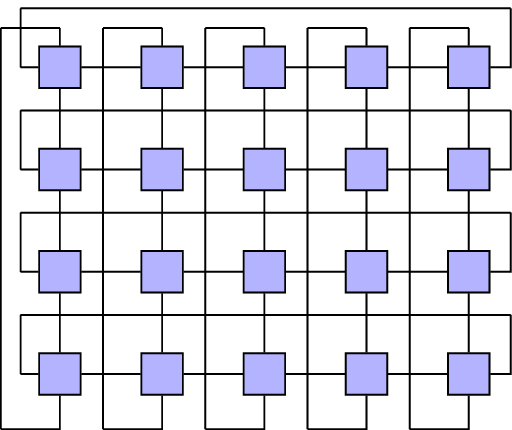Description
This is a TikZ code that generates a diagram composed of rows of blue blocks, where each row is vertically aligned, and the blocks within each row are horizontally aligned. The blocks are connected with straight lines that span vertically between the rows.
The diagram starts with an empty row of nodes, followed by four rows of blocks, with each row consisting of five blocks. Each block is defined as a TikZ style with a blue fill and a minimum width and height of 1em, and a draw command to draw the block border. The arrows and line styles are also defined as TikZ styles.
The nodes and blocks are defined using the TikZ chains library, which provides an easy way to position the blocks relative to each other. The blocks are connected using the join command, which connects the current block to the previous block in the chain.
The diagram is created by drawing vertical lines that connect the blocks between each row, and horizontal lines that loop back from the first block in each row to the last block in the previous row. The coordinates of the blocks and lines are calculated using the TikZ calc library, which allows for easy arithmetic operations on coordinates.
Finally, the diagram is rendered as a standalone TikZ picture using the TikZ standalone class, which provides an easy way to generate standalone diagrams without the need for a full LaTeX document. The resulting output is a PDF file of the diagram.
Keywords
tikzpicture, node, draw, rectangle, fill, text, above, right, left, below, anchor, edge, ->, dotted.
Source Code

\documentclass[tikz]{standalone}
\usetikzlibrary{arrows,chains,positioning,scopes,quotes,bending,calc,intersections}
\tikzset{
block/.style={draw,minimum width=1em,minimum height=1em,align=center,fill=blue!30},
arrow/.style={->},
line/.style={-}
}
\begin{document}
\begin{tikzpicture}[>=stealth',node distance=0.5cm]
% Creating rows of blocks
{[start chain]
\node[on chain] (s0) {};
\node[on chain] (s1) {};
\node[on chain] (s2) {};
\node[on chain] (s3) {};
\node[on chain] (s4) {};
}
{[start chain]
\node[block,on chain, below = 0.15 cm of s0] (A0) {};
\node[block,on chain, join =by {line}] (A1) {};
\node[block,on chain, join =by {line}] (A2) {};
\node[block,on chain, join =by {line}] (A3) {};
\node[block,on chain, join =by {line}] (A4) {};
}
{[start chain]
\node[block,on chain, below = of A0] (B0) {};
\node[block,on chain, join =by {line}] (B1) {};
\node[block,on chain, join =by {line}] (B2) {};
\node[block,on chain, join =by {line}] (B3) {};
\node[block,on chain, join =by {line}] (B4) {};
}
{[start chain]
\node[block,on chain, below = of B0] (C0) {};
\node[block,on chain, join =by {line}] (C1) {};
\node[block,on chain, join =by {line}] (C2) {};
\node[block,on chain, join =by {line}] (C3) {};
\node[block,on chain, join =by {line}] (C4) {};
}
{[start chain]
\node[block,on chain, below = of C0] (D0) {};
\node[block,on chain, join =by {line}] (D1) {};
\node[block,on chain, join =by {line}] (D2) {};
\node[block,on chain, join =by {line}] (D3) {};
\node[block,on chain, join =by {line}] (D4) {};
}
% {[start chain]
% \node[block,on chain, below = of D0] (E0) {};
% \node[block,on chain, join =by {line}] (E1) {};
% \node[block,on chain, join =by {line}] (E2) {};
% \node[block,on chain, join =by {line}] (E3) {};
% \node[block,on chain, join =by {line}] (E4) {};
% }
% Drawing vertical lines
\draw (A0) -- (B0) -- (C0) -- (D0); % -- (E0);
\draw (A1) -- (B1) -- (C1) -- (D1); % -- (E1);
\draw (A2) -- (B2) -- (C2) -- (D2); % -- (E2);
\draw (A3) -- (B3) -- (C3) -- (D3); % -- (E3);
\draw (A4) -- (B4) -- (C4) -- (D4); % -- (E4);
% Drawing loop backs horizontal
\draw (A0.west) -- ($(A0.west) - (0.15, 0)$);
\draw ($(A0.west) - (0.15, 0)$) -- ($(A0.west) - (0.15, 0)+(0,0.5)$);
\draw ($(A0.west) - (0.15, 0)+(0,0.5)$) -- ($(A0.west) +(4,0.5)$);
\draw ($(A0.west) +(4,0.5)$) |- (A4.east);
% \draw (A0.north) |- (s2.north east) -| (A4.north);
% B row
\draw (B0.west) -- ($(B0.west) - (0.15, 0)$);
\draw ($(B0.west) - (0.15, 0)$) -- ($(B0.west) - (0.15, 0)+(0,0.5)$);
\draw ($(B0.west) - (0.15, 0)+(0,0.5)$) -- ($(B0.west) +(4,0.5)$);
\draw ($(B0.west) +(4,0.5)$) |- (B4.east);
% C row
\draw (C0.west) -- ($(C0.west) - (0.15, 0)$);
\draw ($(C0.west) - (0.15, 0)$) -- ($(C0.west) - (0.15, 0)+(0,0.5)$);
\draw ($(C0.west) - (0.15, 0)+(0,0.5)$) -- ($(C0.west) +(4,0.5)$);
\draw ($(C0.west) +(4,0.5)$) |- (C4.east);
% D row
\draw (D0.west) -- ($(D0.west) - (0.15, 0)$);
\draw ($(D0.west) - (0.15, 0)$) -- ($(D0.west) - (0.15, 0)+(0,0.5)$);
\draw ($(D0.west) - (0.15, 0)+(0,0.5)$) -- ($(D0.west) +(4,0.5)$);
\draw ($(D0.west) +(4,0.5)$) |- (D4.east);
% E row
%\draw (E0.west) -- ($(E0.west) - (0.15, 0)$);
%\draw ($(E0.west) - (0.15, 0)$) -- ($(E0.west) - (0.15, 0)+(0,0.5)$);
%\draw ($(E0.west) - (0.15, 0)+(0,0.5)$) -- ($(E0.west) +(4,0.5)$);
%\draw ($(E0.west) +(4,0.5)$) |- (E4.east);
% Vertical Loopbacks
% 0 column
\draw (A0.north) -- ($(A0.north) + (0.0, 0.15)$);
\draw ($(A0.north) + (0, 0.15)$) -- ($(A0.north) + (0, 0.15)+(-0.5,0)$);
\draw ($(A0.north) + (0, 0.15)+(-0.5,0)$) -- ($(D0.north) +(-0.5,-0.65)$);
\draw ($(D0.north) +(-0.5,-0.65)$) -| (D0.south);
% 1 column
\draw (A1.north) -- ($(A1.north) + (0.0, 0.15)$);
\draw ($(A1.north) + (0, 0.15)$) -- ($(A1.north) + (0, 0.15)+(-0.5,0)$);
\draw ($(A1.north) + (0, 0.15)+(-0.5,0)$) -- ($(D1.north) +(-0.5,-0.65)$);
\draw ($(D1.north) +(-0.5,-0.65)$) -| (D1.south);
% 2 column
\draw (A2.north) -- ($(A2.north) + (0.0, 0.15)$);
\draw ($(A2.north) + (0, 0.15)$) -- ($(A2.north) + (0, 0.15)+(-0.5,0)$);
\draw ($(A2.north) + (0, 0.15)+(-0.5,0)$) -- ($(D2.north) +(-0.5,-0.65)$);
\draw ($(D2.north) +(-0.5,-0.65)$) -| (D2.south);
% 3 column
\draw (A3.north) -- ($(A3.north) + (0.0, 0.15)$);
\draw ($(A3.north) + (0, 0.15)$) -- ($(A3.north) + (0, 0.15)+(-0.5,0)$);
\draw ($(A3.north) + (0, 0.15)+(-0.5,0)$) -- ($(D3.north) +(-0.5,-0.65)$);
\draw ($(D3.north) +(-0.5,-0.65)$) -| (D3.south);
% 4 column
\draw (A4.north) -- ($(A4.north) + (0.0, 0.15)$);
\draw ($(A4.north) + (0, 0.15)$) -- ($(A4.north) + (0, 0.15)+(-0.5,0)$);
\draw ($(A4.north) + (0, 0.15)+(-0.5,0)$) -- ($(D4.north) +(-0.5,-0.65)$);
\draw ($(D4.north) +(-0.5,-0.65)$) -| (D4.south);
\end{tikzpicture}
\end{document}